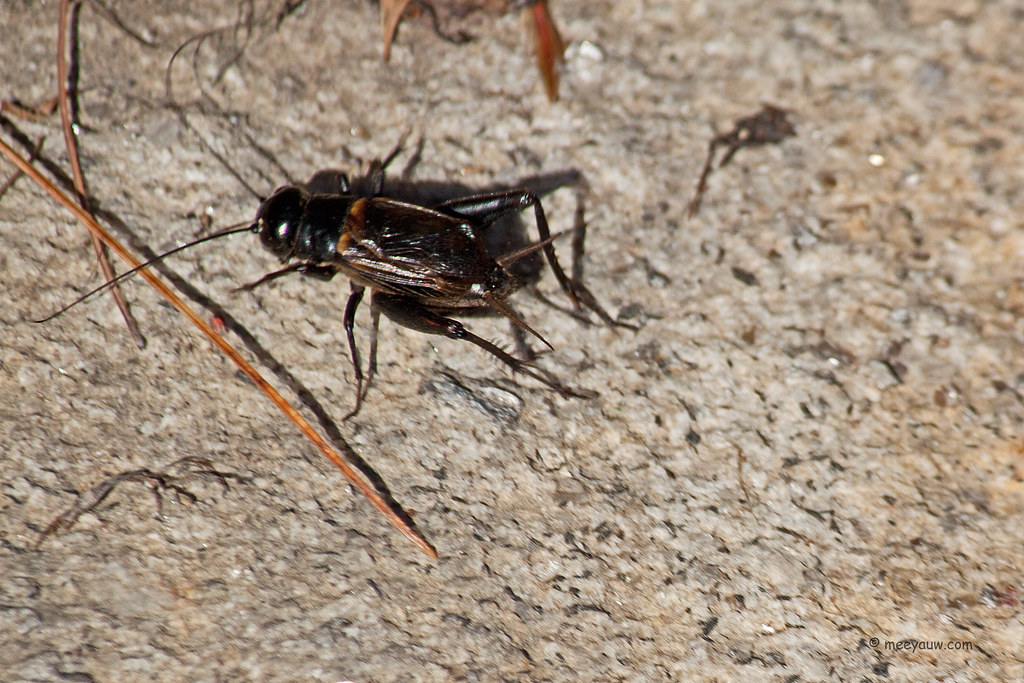These are the big, black crickets that you see in late summer and in the autumn. The Old Farmer's Almanac gives us our cricket lore:
More information from the Almanac:Did you know that you can tell the temperature by counting the chirps of a cricket? It's true! Here's the formula:
To convert cricket chirps to degrees Fahrenheit, count number of chirps in 14 seconds then add 40 to get temperature.
Example: 30 chirps + 40 = 70° F
To convert cricket chirps to degrees Celsius, count number of chirps in 25 seconds, divide by 3, then add 4 to get temperature.
Example: 48 chirps /(divided by) 3 + 4 = 20° C
On our kids' Web site (summer and fall only), you can hear a cricket chirp change speed depending on the temperature you choose. Listen here.
Crickets
♫ A field cricket is shiny black, with brown wings. Despite Disney's Jiminy Cricket, there is no such thing as a green cricket.
♫ A fully-grown male is less than an inch long, while the female cricket is about 50% longer.
♫ Only male crickets can sing.
♫ Crickets, unlike grasshoppers, are short and stubby, and won't jump, except in desperation.
♫ Female crickets lay their eggs in the fall. When they hatch in May or early June there are thousands of tiny black crickets,
but by July they are bigger and large enough to start singing.
♫ To sing, male crickets lift their wing casings at a 45° angle and rub them together.
♫ Crickets and eat and sing at the same time.
♫ Like all insects, crickets are cold-blooded and they sing faster or slower depending on the temperature.
New Hampshire Public Radio published Cricket Thermometer back in August of 2009. Apparently you can’t use our little cricket rule of thumb in New Hampshire:
Un-mowed fields and "waste places" are considered unproductive in terms of bales of hay produced, but they are teeming with insects. Ants, butterflies, moths, spiders, grasshoppers and crickets thrive beyond the realm of lawnmowers.
Worldwide, there are 900 species of crickets. Often confused with grasshoppers because they both have long hind legs for jumping, crickets have flattened bodies and long antennae. Green grasshoppers are active by day and brown or black field crickets are nocturnal. The evening chorus of male field crickets is the soundtrack of late summer.
Crickets mate in late summer and lay as many as 2,000 eggs per fertile female in late fall. To attract females, male crickets “stridulate” by scraping one wing against a specialized toothed comb on the underside of the opposite wing. Wing membranes help to amplify and direct the sound. Each cricket species chirps in a characteristic pitch.
The rate of chirping is influenced by air temperature. Insects are cold-blooded. As temperatures rise, the muscle contractions used to produce chirping happen more rapidly. When temperatures fall, chemical reactions influencing muscle contractions slow.
In 1897, Amos Dolbear, perhaps unable to sleep, formulated an estimate of the temperature In Fahrenheit by counting cricket chirps. Using Dolbear's Law, count the number of chirps produced in 15 seconds and then add 40 to use the cricket thermometer. The chirping of fall field crickets in New Hampshire cannot be precisely correlated to temperature because the rate varies with age and mating success.
In the US, cricket chirping indicates dramatic silence - like at the end of a long and complex monologue which ends with a question… Know what I mean?
_/\_/\_

No comments:
Post a Comment
Thank you for leaving a comment on meeyauw's pad. I enjoy reading constructive comments, tips and ideas that help me improve my photographs.